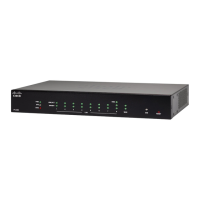Result The PC2 address is 172.16.1.110, and can access PC1 by http://172.16.1.1. Change the PC address to
another address out of the range 172.16.1.100-110, if it cannot access the internal server.
Case 7
Only allows particular Internet hosts to access the LAN server by 1:1 like rule.
Topology PC1/PC10 –– LAN[RV260W]WAN –– PC2
• PC1: 192.168.1.111/24
• RV260W LAN: 192.168.1.1/24
• RV260W WAN: 172.16.1.1/24, GW 172.16.1.2
• PC2: 172.16.1.110
Address Object: Configure allowed_hosts to 172.16.1.100-110, WAN_alias to 172.16.1.10 and PC1 to
192.168.1.111.
Result: Only the hosts in the 172.16.1.100-110 range can access PC1 via 172.16.1.10.
Session Timeout
In the Session Timeout section, you can configure the session time-out and maximum concurrent connections
for the TCP/UDP/ICMP flows. The session timeout is the time it takes for the TCP or UDP session to time
out after a period of idleness.
To configure the Session Timeout, follow these steps:
Step 1 Click Firewall > Session Timeout.
Step 2 Enter the following:
Enter the timeout value in seconds for TCP sessions. Inactive TCP sessions are removed
from the session table after this duration (Default 1800, Range 30 to 1800).
TCP Session Timeout
Enter the timeout value in seconds for UDP sessions. Inactive UDP sessions are removed
from the session table after this duration (Default 30, Range 30 to 86400).
UDP Session Timeout
Enter the timeout value in seconds for ICMP sessions. Inactive ICMP sessions are
removed from the session table after this duration (Default 30, Range 15 to 60).
ICMP Session Timeout
Enter the maximum number of concurrent connections allowed (Default 25000, Range
10000 to 25000).
Maximum Concurrent
Connections
Displays the number of current connections.Current Connections
Click to clear the current connections.Clear Connections
Step 3 Click Apply.
RV260x Administration Guide
86
Firewall
Session Timeout

